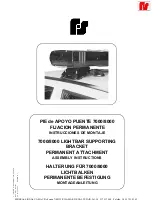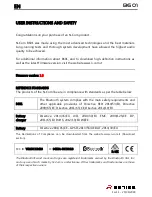
Electrical Maintenance
83
Testing the Flywheel (RPM) Sensor:
The following equipment is required:
•
AC voltmeter capable of reading up to 10
volts
•
Ohmmeter
The flywheel sensor may be checked as follows:
1. Position the flywheel so a ring gear tooth is in
the center of the sensor mount hole.
2. Turn the flywheel sensor into the starter
mounting flange until it contacts the ring gear.
Back out the sensor 1/4 turn and tighten the
locknut.
Figure 149: Flywheel (RPM) Sensor
3. Disconnect the FS1 and FS2 wires from the
sensor.
Figure 150: Flywheel (RPM) Sensor Wires
4. Run the unit on low speed and high speed.
Check the AC voltage output across the sensor
terminals. Use a meter with a high ohms per
volt internal resistance. A Simpson 260, Fluke
digital or any good VOM will work. However,
an automotive type meter may not give an
accurate reading because the meter may load
the circuit heavily and cause the voltage level
to appear lower than it actually is.
a. The output voltage should be 1.0 to
2.0 Vac on low speed.
b. The output voltage should be 2.0 to
2.5 Vac on high speed.
NOTE: If the voltage is slightly off, the
voltage may be increased by turning the
sensor in more, and the voltage may be
lowered by turning the sensor out more.
5. Reconnect the FS1 and FS2 wires to the
sensor.
If the flywheel sensor passes the above test, the
sensor may be considered good.
If the engine will not start, an alternate less
reliable test may be performed as follows:
Disconnect the sensor from all wires, and measure
the resistance across the terminals and from each
terminal to the aluminum case. The resistance
should be 250 to 300 ohms across the terminals,
and there should be no continuity from each
terminal to the case.
Glow Plugs
Glow plugs heat the combustion chamber to aid in
quick starting. The glow plugs are energized when
the microprocessor initiates unit start-up. A
defective glow plug (burned out) can be detected
by placing a clamp-on ammeter on the H wire to
the glow plugs. Normal current draw during
preheat is approximately 11 to 13 amps. A current
draw in this range means all three glow plugs are
working. If the current draw during preheat is less
than this, at least one glow plug is bad.
To isolate an open circuit glow plug, remove the
wires and test each glow plug individually with an
ohmmeter or a jumper wire and ammeter. Each
glow plug should have a resistance of 2.3 ohms.
The current draw for each glow plug should be
approximately 4.3 amps.
1.
Remove Wires
2.
Ohmmeter
3.
2.3 Ohms
Figure 151: Glow Plug Ohm Test
1
2
3
Summary of Contents for UT-1200
Page 10: ...Table of Contents 10...
Page 20: ...Safety Precautions 20...
Page 76: ...Operating Instructions for Premium HMI Control Panel 76...
Page 88: ...Electrical Maintenance 88...
Page 98: ...Engine Maintenance 98 Figure 167 Fuel Components...
Page 142: ...Refrigeration Service Procedures 142...
Page 148: ...Clutch Maintenance 148...
Page 150: ...Structural Maintenance 150...
Page 162: ...Wiring and Schematic Diagrams Index 162...
Page 163: ...163 Schematic Diagram Page 1 of 2...
Page 164: ...164 Schematic Diagram Page 2 of 2...
Page 165: ...165 Wiring Diagram Page 1 of 5...
Page 166: ...166 Wiring Diagram Page 2 of 5...
Page 167: ...167 Wiring Diagram Page 3 of 5...
Page 168: ...168 Wiring Diagram Page 4 of 5...
Page 169: ...169 Wiring Diagram Page 5 of 5...
















































